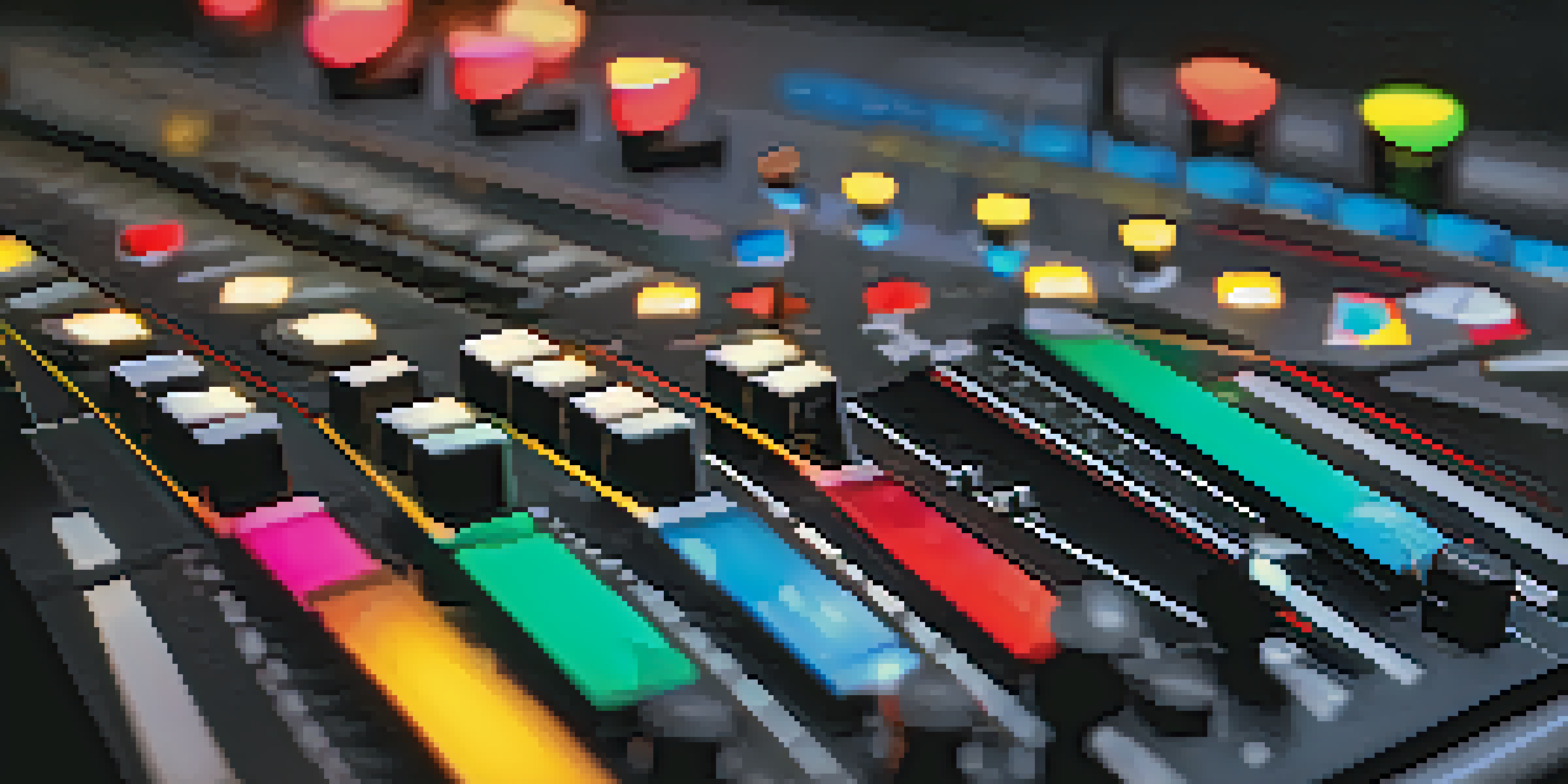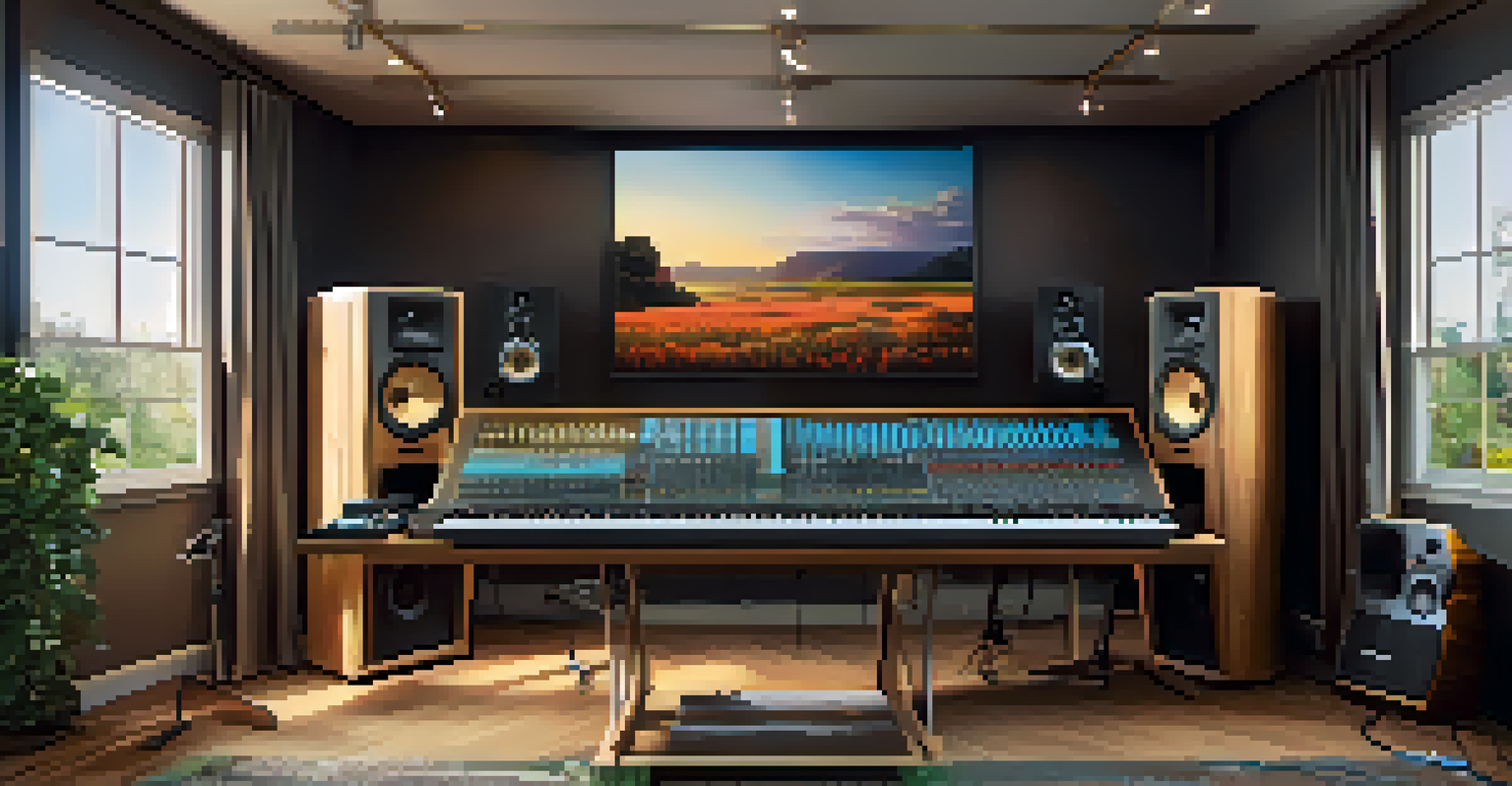Advanced Techniques for Live Sound Mixing and Effects

Understanding the Basics of Live Sound Mixing
Before diving into advanced techniques, it's crucial to grasp the fundamentals of live sound mixing. This includes understanding the signal flow, which is the path audio signals take from microphones to speakers. Knowing how to balance levels, frequencies, and dynamics lays the groundwork for more complex techniques.
Music is the shorthand of emotion.
Think of it like cooking; you need to master basic recipes before you can create gourmet dishes. Each sound source in a live setting—like vocals, instruments, and effects—has its unique flavor. By understanding their characteristics, you can create a harmonious blend that enhances the overall experience.
Additionally, familiarity with your mixing console is vital. Whether it's analog or digital, each console has unique features that can streamline your workflow. The more comfortable you are with these tools, the more effectively you can implement advanced techniques.
Utilizing Equalization for Enhanced Clarity
Equalization, or EQ, is one of the most powerful tools in live sound mixing. It allows you to adjust the balance of frequencies within an audio signal, helping to eliminate muddiness and enhance clarity. For instance, boosting high frequencies can help vocals cut through the mix, while cutting low frequencies can reduce unwanted rumble.

Imagine EQ as a sculptor shaping a block of marble; you remove what doesn't fit to reveal a masterpiece. By carefully applying EQ, you can ensure each instrument occupies its own space in the frequency spectrum, making the overall mix more transparent and enjoyable.
Mastering Sound Mixing Basics
Understanding signal flow and the characteristics of sound sources is essential for crafting a harmonious live mix.
However, it's essential to use EQ judiciously. Over-equalizing can lead to unnatural sounds, so always trust your ears and make adjustments based on the context of the performance. Remember, the goal is to enhance the sound, not to completely alter its essence.
Dynamic Control: Compression and Limiting
Dynamic control is another key component of live sound mixing, often achieved through compression and limiting. These tools help manage the volume levels of audio signals, ensuring that no sound is too loud or too soft. For example, a compressor can smooth out vocal dynamics, making softer passages more audible without overpowering louder sections.
The more you know, the more you realize you don’t know.
Think of compression like a good friend who helps keep you grounded during emotional highs and lows. By applying compression, you can maintain a consistent level in your mix, preventing any moment from being drowned out or lost.
Limiting, on the other hand, acts as a safety net, preventing audio from clipping and causing distortion. This is particularly important in live settings where unpredictable volume spikes can occur. Understanding how to effectively use these tools will enhance your mixing capabilities.
Creating Depth with Reverb and Delay Effects
Reverb and delay are essential effects for adding depth and dimension to live sound. Reverb simulates the natural reflections of sound in a space, while delay creates echoes that can enhance rhythmic elements. By using these effects thoughtfully, you can transport your audience into a richer auditory landscape.
Imagine standing in a cathedral versus a small room; the difference in sound is striking. By adjusting the parameters of reverb, such as size and decay time, you can evoke the desired ambiance for your performance, making it feel more immersive.
Enhancing Clarity with EQ
Using equalization effectively can sculpt audio frequencies, ensuring each sound occupies its own space in the mix.
Delay can also be a powerful tool for creating rhythmic interest. A well-timed delay can add a layer of complexity to a performance, making it feel more dynamic. However, moderation is key; too much reverb or delay can muddy the mix, so always listen critically.
Advanced Techniques: Parallel Processing
Parallel processing is an advanced technique that involves duplicating audio tracks and processing them separately before blending them back together. This allows for more creative control, as you can apply different effects or levels of compression to each track. For example, you might have a dry vocal track and a heavily compressed parallel track, creating a fuller sound without losing the natural quality.
Think of parallel processing as layering flavors in a dish. Just as a chef might add spices to enhance a meal, parallel processing can make your audio more vibrant and engaging. The key is to find the right balance; too much of one element can overpower the others.
This technique is particularly useful in live settings where you want to maintain clarity while adding richness. By experimenting with parallel processing, you can discover new sounds and textures that elevate your mixes.
Implementing Automation for Dynamic Mixing
Automation is a game-changer in live sound mixing, allowing you to control various parameters in real-time. With automation, you can adjust levels, effects, and panning on-the-fly, responding to the performance as it unfolds. This is particularly useful in dynamic live environments where the energy can shift quickly.
Think of automation like a conductor leading an orchestra; it helps ensure that every element comes together seamlessly. By automating certain parameters, you can create a more dynamic and engaging mix that captivates the audience.
Dynamic Control with Compression
Applying compression and limiting helps manage volume levels, providing a consistent and polished live sound experience.
Many digital mixing consoles offer automation features, making it easier to implement this technique. However, it requires practice and a good ear to know when and how to make adjustments, so don't hesitate to experiment during rehearsals.
Integrating Technology: Digital Effects and Plugins
As technology advances, integrating digital effects and plugins into live sound mixing has become increasingly popular. These tools offer a wide range of possibilities, from virtual instruments to sophisticated effects that can enhance your mix. For instance, using a digital plugin for a vintage compressor can give you the warmth of analog gear without the bulk.
Think of digital effects as a toolbox filled with specialized tools for different tasks. Whether you want to add a lush chorus effect or a gritty distortion, there’s likely a plugin that can help achieve your vision. The flexibility of digital tools allows for greater creativity in live performances.

However, it’s important to strike a balance between digital and analog. While digital effects can be powerful, they shouldn’t overshadow the natural sound of the instruments. Always consider the overall aesthetic of the performance and use digital tools to complement, rather than replace, the organic sound.